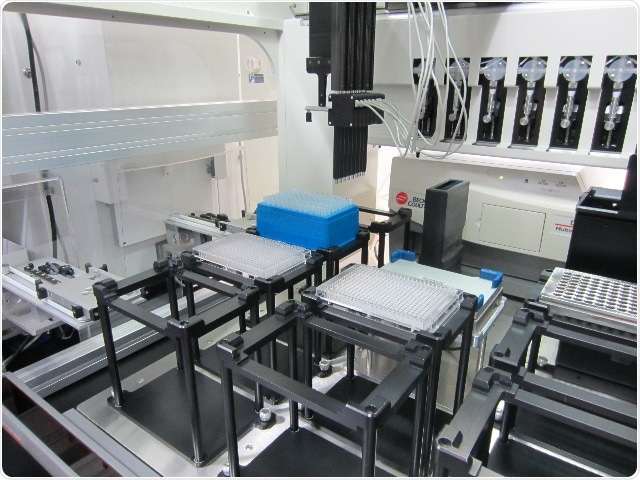A group of researchers, from the RIKEN Center for Biosystems Dynamics Research (BDR) based in Japan, has successfully evolved the common microorganisms Escherichia coli at the experimental level and under pressure from a huge number of individual antibiotics.

An automated robotic culture system to perform high-throughput laboratory evolution of E. coli. Image Credit: RIKEN.
While doing so, the team effectively identified the mechanisms and limitations that are fundamental to the evolved resistance of E. coli bacteria to drugs.
The latest findings can help scientists design new drug-treatment techniques that decrease the chance of drug resistance that might be developed by bacteria. The study was published in Nature Communications—a scientific journal.
Offsetting the effect of multidrug-resistant bacteria is turning out to be a crucial challenge worldwide. It appears that whenever novel antibiotics are developed, new antibiotic-resistant microorganisms also evolve during clinical use.
To overcome this cat-and-mouse game, it is crucial to figure out how bacteria develop drug resistance. Evidently, such a process is highly complicated, which involves multiple changes in cellular states and genome sequences. As a result, a detailed analysis of resistance dynamics for huge numbers of antibiotic drugs has never been reported to date.
Laboratory evolution combined with genomic analyses is a promising approach for understanding antibiotic resistance dynamics. However, laboratory evolution is highly labor-intensive, requiring serial transfer of cultures over a long period and a large number of parallel experiments.”
Tomoya Maeda, Study Lead and Researcher, RIKEN Center for Biosystems Dynamics Research
Maeda further added that detecting the genes that promote resistance to antibiotics is not invariably easy, and this can be attributed to the extensive number of genetic traits that are contained inside the data.
Hence to resolve these constraints, the researchers designed an automated robotic culture system that enabled them to effectively carry out high-throughput laboratory evolution of E. coli for over 250 generations under pressure from a total of 95 different antibiotic drugs.
Armed with this new capability, the team was able to measure the changes in the transcriptome of the bacteria; transcriptome refers to the set of all messenger RNAs and their transcripts, which is the record of which kinds of genes are truly expressed.
Consequently, the system generated resistance profiles for a total of 192 of the evolved strains. The investigators also designed a machine-learning technique for studying this vast quantity of data. This enabled them to detect both new and familiar genes that play a role in predicting the evolution of resistance.
We found that E. coli’s evolutionary dynamics is attributable to a relatively small number of intracellular states, indicating that it is likely equipped with only a limited number of strategies for antibiotic resistance.”
Tomoya Maeda, Study Lead and Researcher, RIKEN Center for Biosystems Dynamics Research
By being able to quantify the limitations that impact the evolution of antibiotic resistance in E. coli bacteria, the researchers believe that they can estimate and, thus, regulate antibiotic resistance.
For instance, the researchers used the novel system and successfully tested 2162 pairs of drug combinations. They ultimately found as many as 157 pairs that could help inhibit antibiotic resistance acquisition in E. coli bacteria.
We believe that our results can be applied to the development of alternative strategies for suppressing the emergence of drug-resistant bacteria.”
Tomoya Maeda, Study Lead and Researcher, RIKEN Center for Biosystems Dynamics Research
Source:
Journal reference:
Maeda, T., et al. (2020) High-throughput laboratory evolution reveals evolutionary constraints in Escherichia coli. Nature Communications. doi.org/10.1038/s41467-020-19713-w.